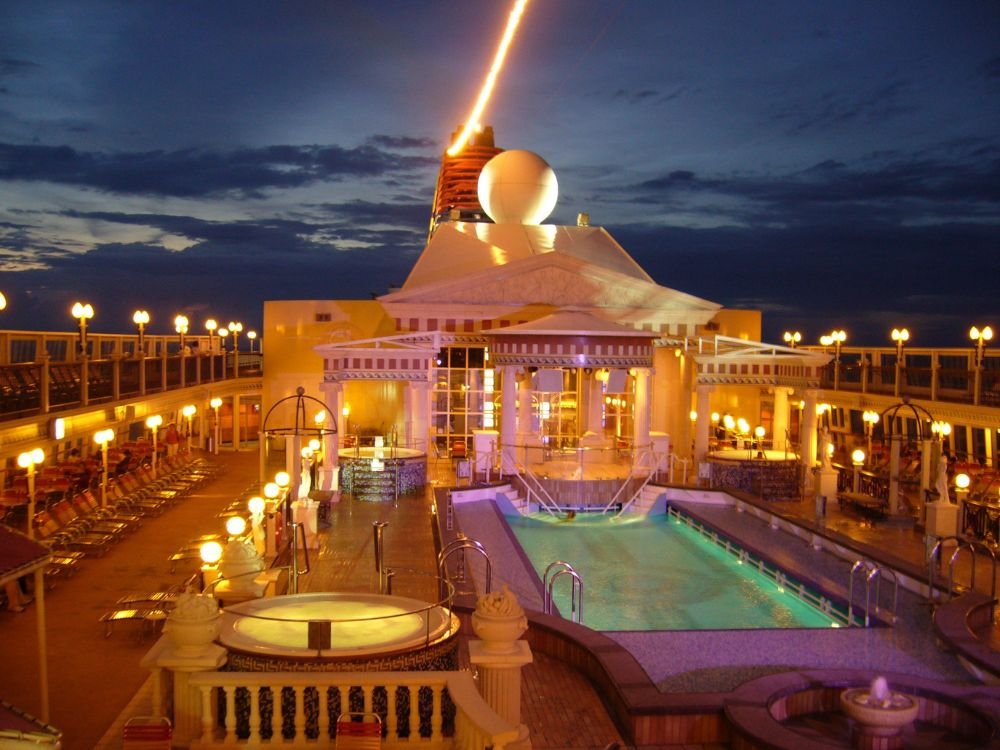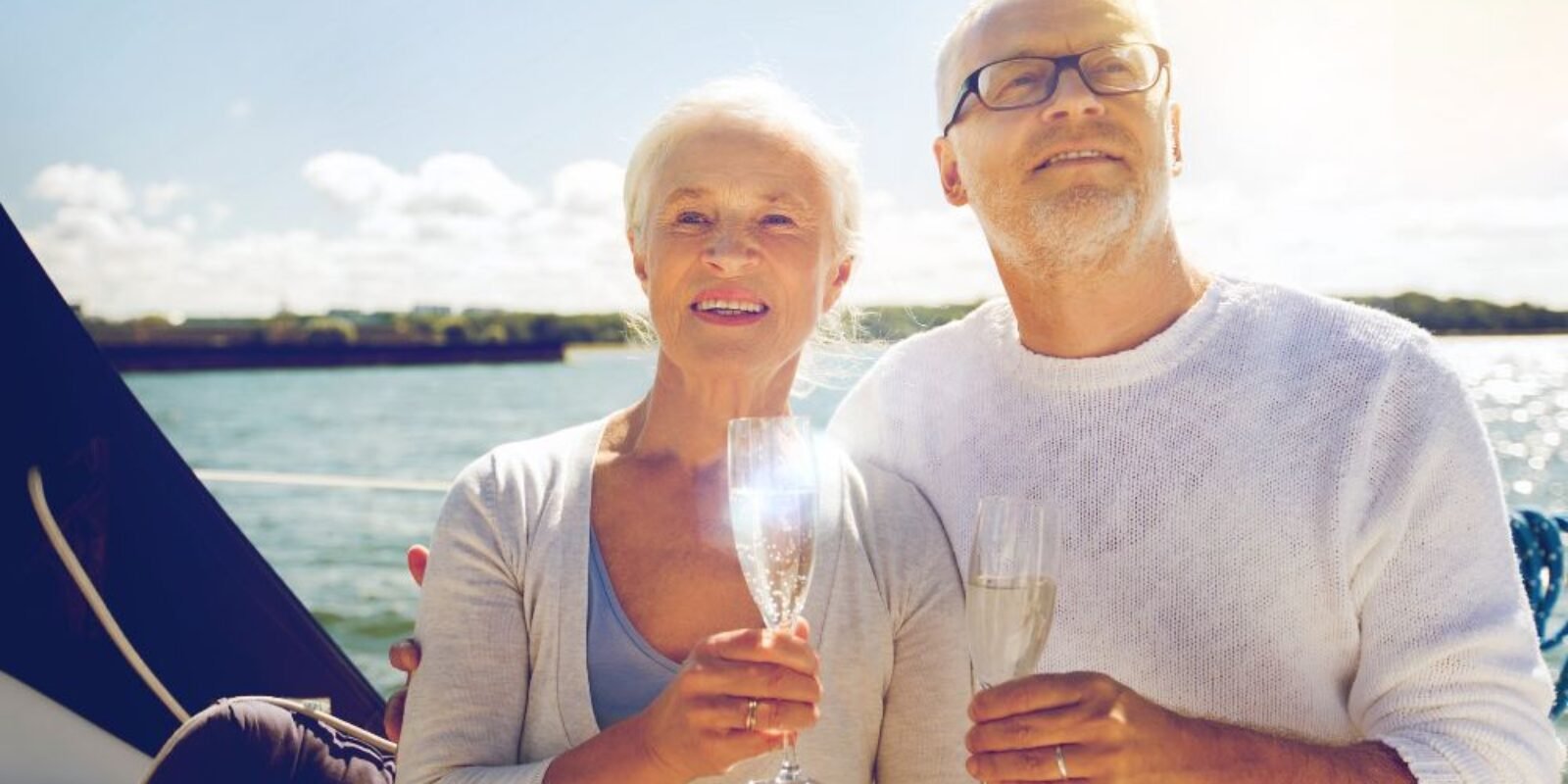Last Updated on June 27, 2025 by Julian Espinosa
Are you dreaming of waking up to ocean views while savoring world-class cuisine, then exploring exotic destinations without ever packing a suitcase? Cruise retirement might be the adventure you’ve been searching for! This lifestyle combines the excitement of continuous travel with the comfort of a floating home, where housekeeping, dining, and entertainment are all taken care of for you.
Today’s seniors are discovering three main pathways to cruise retirement: back-to-back cruising for maximum flexibility, purchasing a cruise condo for permanent residence at sea, and extended voyages that can last months or even years. Each option offers unique benefits and considerations, from costs ranging from approximately $259 per day for traditional cruising to one-time payments starting at $129,999 for residential ship ownership.
Whether you’re seeking the spontaneity of choosing different cruise lines and destinations, the stability of owning your floating home, or the immersive experience of multi-month journeys, cruise retirement transforms your golden years into an endless vacation. The key is understanding which option aligns with your lifestyle preferences, health considerations, and financial planning. Ready to discover how to turn retirement into a lifetime adventure?
Cruise Retirement: Exploring Your Options for Life at Sea
Back-to-back cruising represents the ultimate in retirement flexibility. This lifestyle involves booking consecutive cruises, allowing you to stay at sea for weeks or months while exploring different destinations and experiencing various cruise lines. As one voyage ends, you transition to the next, avoiding the need to return home between trips.
This approach particularly appeals to seniors who value variety and spontaneity. You might find yourself exploring the Caribbean’s turquoise waters one month, then marveling at Alaska’s glaciers the next—all while maintaining the familiar comfort of cruise life. Many retirees strategically use cruise line loyalty programs to secure perks like priority boarding, cabin upgrades, and reduced rates, making this lifestyle even more attractive.
The beauty of back-to-back cruising lies in its adaptability. You can adjust your itinerary based on seasons, special interests, or simply follow your wanderlust wherever it leads.

Prefer to listen than read?
Back-to-Back Cruises
Back-to-back cruises are a popular option for retirees who want to enjoy continuous cruising without committing to one ship or itinerary. This lifestyle involves booking consecutive cruises, often on the same ship, but sometimes rotating between different vessels. It allows retirees to explore multiple destinations while maintaining the excitement of life at sea. The concept is simple: as one cruise ends, you embark on another, avoiding the need to return home.
This option appeals to those who value variety and spontaneity in retirement. You can enjoy tropical beaches one month and majestic fjords the next, all while indulging in the comforts of cruise life. Retirees often take advantage of cruise line loyalty programs, which offer perks like priority boarding and discounted rates, making back-to-back cruising even more appealing. For those who thrive on adventure and flexibility, this option provides a dynamic way to enjoy retirement.
Costs of Back-to-Back Cruises
According to industry statistics, the average person spent approximately $259 per day aboard a cruise ship in 2024, though costs vary significantly based on cruise line, cabin category, and itinerary choice. Budget-conscious retirees can find more affordable options, while those seeking luxury experiences might invest several hundred dollars daily.
Many cruise lines offer discounts for repeat customers or those booking multiple consecutive sailings, which can substantially reduce overall costs. Some lines even provide special rates specifically for long-term cruisers. Remember that gratuities average about $18.50 per person per day for regular staterooms and $21.00 per person per day for suites, plus additional costs for specialty dining, shore excursions, and travel insurance.
When you factor in the value of included accommodations, meals, entertainment, and utilities, many retirees find back-to-back cruising surprisingly affordable compared to maintaining a traditional home.
Advantages of Back-to-Back Cruises
Back-to-back cruising offers unprecedented freedom and excitement for your retirement years. You have complete control over your journey, selecting destinations and cruise lines that match your interests while keeping each voyage fresh and engaging. Every sailing brings new fellow passengers, creating countless opportunities to forge friendships with people from diverse backgrounds.
The convenience factor cannot be overstated. You’ll wake up in a different location almost daily without the stress of airport security, luggage handling, or hotel check-ins. Your comfortable cabin remains your consistent home base throughout your adventures, complete with all the amenities and personal touches that make you feel at ease.
- Offers flexibility and freedom to explore various destinations and cruise lines.
- Provides opportunities to meet new people with every sailing, fostering social connections.
- Includes gourmet dining, entertainment, and onboard activities for an enjoyable experience.
- Eliminates the hassle of airport travel and repetitive packing and unpacking.
- Allows retirees to wake up in a new location almost daily while enjoying the comfort of a consistent cabin.
- Offers an all-inclusive lifestyle that reduces daily stress, making it a great retirement option for those who love variety and new experiences.

Disadvantages of Back-to-Back Cruises
While back-to-back cruising has many perks, it’s not without its challenges. One of the main drawbacks is the constant need to rebook and plan future sailings. Even with loyalty programs, there’s always a risk that your preferred itinerary or cabin can not be available. Retirees can also find the process of disembarking and reboarding between cruises tedious, especially if immigration procedures are required.
The frequent change in surroundings can feel unsettling for those who value stability or routine. Additionally, while cruising is inclusive, extra costs like excursions, specialty dining, and gratuities can add up, making budgeting more complex. Health considerations also play a role, as extended time at sea can not be ideal for individuals with specific medical needs that cannot be accommodated onboard. Despite these challenges, many retirees find that the benefits far outweigh the drawbacks, particularly when careful planning is involved.
- Requires constant planning and rebooking, which can be time-consuming.
- Preferred itineraries or cabins may not always be available, even with loyalty programs.
- The process of disembarking and reboarding can become tedious, particularly with immigration requirements.
- Frequent changes in surroundings can feel unsettling for those who value routine or stability.
- Additional costs for excursions, specialty dining, and gratuities can complicate budgeting.
- Extended time at sea may not suit individuals with specific medical needs that are difficult to address onboard.
Back-to-back cruises are an exciting option for retirees who crave adventure and variety. With the right planning and financial management, this lifestyle offers the perfect blend of exploration and comfort. Whether you’re a seasoned cruiser or a first-timer considering this lifestyle, back-to-back cruises provide an opportunity to embrace retirement as a time of continuous discovery.
Cruise Condo or Apartment Purchase
Purchasing a cruise condo or apartment is an innovative option for retirees who want a permanent residence at sea. Unlike traditional cruising, this approach allows individuals to own a private space aboard a ship designed for long-term living. These floating homes are part of ships that function more like residential communities than vacation vessels.
Retirees can personalize their apartments, creating a true home away from home while enjoying access to world-class amenities, dining options, and onboard activities. Cruise condos offer stability, as you’re not constantly switching cabins or itineraries. The ship typically follows a set route or world-travel itinerary, allowing owners to enjoy a mix of new destinations and familiar comforts. Cruise condo living is a unique and appealing option for retirees who prefer the security and consistency of owning their living space while still exploring the world.

Costs of Cruise Condo or Apartment Purchase
The costs of purchasing a cruise condo can vary significantly depending on the ship, apartment size, and onboard amenities. Entry-level units can start at several hundred thousand dollars, while luxury condos with more space and premium locations on the ship can reach millions. In addition to the initial purchase price, owners often pay monthly maintenance fees, which cover utilities, staff services, and ship operations.
These fees can range from a few thousand to over ten thousand dollars per month, depending on the level of luxury and services provided. There can also be additional expenses for food, beverages, and optional activities not included in the ownership package. While the upfront cost is substantial, many retirees find it comparable to buying property on land in a prime location. The added value of travel, all-inclusive services, and onboard facilities often makes it a worthwhile investment for those with the financial means.
Advantages of Cruise Condo or Apartment Purchase
For those looking for a lavish retirement, owning a cruise apartment presents a special combination of security and excitement. Your apartment is your permanent residence. Unlike back-to-back cruising, there is no need to continually rebook or pack and unload. Customizing your surroundings guarantees a personal touch and helps you to feel really at home living at sea.
These ships often provide a feeling of community as inhabitants usually get close to their crew members and neighbors. Along with exploring new locations without worrying about travel issues, you can enjoy onboard food, entertainment, and spa amenities. Many cruise condo ships have first-rate medical services, giving seniors with continuing medical requirements peace of mind. Owning a cruise apartment is an unrivaled chance for people who appreciate long-term luxury, solitude, and the freedom to explore.
- Provides a permanent, customizable residence at sea, eliminating the need for constant rebooking or packing.
- Combines stability with the thrill of travel, as your home moves with you while exploring various destinations.
- Offers privacy and personalization, allowing retirees to create a comfortable living space.
- Includes access to world-class amenities, such as dining, entertainment, and wellness facilities.
- Fosters a sense of community with other residents and crew, creating strong social bonds.
- Often equipped with onboard healthcare facilities, ensuring peace of mind for retirees with medical needs.

Disadvantages of Cruise Condo or Apartment Purchase
For retirees seeking a more permanent solution, purchasing a cruise condo or apartment aboard a residential ship offers an innovative approach to retirement living. Unlike traditional cruising, this option allows you to own a private space aboard a vessel designed specifically for long-term living rather than short-term vacations.
Residential cruising options are now available with villa ownership starting at $99,999 for inside accommodations and ranging up to $499,999 for premium double-occupancy units. These floating communities function more like maritime neighborhoods than traditional cruise ships, allowing residents to personalize their living spaces and create genuine homes at sea.
Modern residential ships like the Villa Vie Odyssey offer 3½-year world cruises, visiting hundreds of destinations while providing residents with a stable home base. The ship typically follows carefully planned itineraries that balance exploration with the community needs of long-term residents.
- Requires a significant financial commitment, with upfront purchase costs and monthly maintenance fees.
- Additional expenses for food, beverages, and excursions can increase overall costs.
- Fixed itineraries can limit travel flexibility, as the ship’s schedule caters to all residents.
- Close-knit community living can feel restrictive for those who prefer solitude or independence.
- The niche market for resale can make it challenging to sell the property if needed.
- High costs and specific lifestyle requirements will not suit every retiree’s financial or personal preferences.
A cruise condo or apartment gives retirees a special approach to mix excitement with stability. Although it’s a big financial outlay, it offers a luxury and customized retirement. With the correct tools and preparation, this choice can make your golden years an amazing trip.

Long-Term Cruises
Often spanning several months or perhaps a year, long-term cruises allow retirees to spend protracted times at sea. These trips are meant for people who like to see various locations without continuous travel planning and rebooking. Usually visiting several continents, exotic locations, and famous sites on one trip, long-term cruises follow thorough itineraries. They mix the excitement of discovery with the comfort of going back to the same cabin following every trip.
Long-term cruises offer a great option for seniors who appreciate a planned vacation experience while still enjoying the conveniences of all-inclusive living to tour the globe. For these longer travels, some cruise companies provide custom experiences like enrichment classes, themed activities, and special shore excursions. This alternative is perfect for those eager to welcome a slower, immersed pace of travel without sacrificing luxury and convenience.
Costs of Long-Term Cruises
Long-term cruise expenses rely on elements such as the cruise line, length of the trip, and kind of stateroom. Long-term cruises, on average, cost anywhere from $20,000 to $100,000 per person for many months. Luxury cruises run over these figures. Usually including lodging, food, entertainment, and access to facilities such as libraries, pools, and fitness centres.
To cut further costs, some packages additionally cover gratuities, Wi-Fi, and flights to and from embarkation sites. Retirees should, however, budget for additional expenses such as travel insurance, alcohol, specialty dining, and shore excursions. Particularly when factoring in the savings on utilities, food, and entertainment, many retirees discover that long-term cruises are more reasonably priced than keeping a house on land despite their great initial outlay. Long-term cruises might be a financially reasonable choice for people who prefer grouping their costs into one payment and savoring a rich travel experience.
In terms of travel insurance, you want to ensure your premiums provide the right coverage no matter where you go. Travelex is one of the award-winning insurance companies that offers 24/7 assistance and up to $50,000 medical coverage with their Travel Med Go plan.
Advantages of Long-Term Cruises
Long-term cruises provide seniors an easy and stress-free approach to having an exciting retirement. One of the main benefits is the convenience of organizing a single long trip instead of several. Retirees can unwind and concentrate on seeing each location with everything included: accommodations, food, and entertainment. Often broad and varied, the itineraries let travelers visit dozens of nations and encounter different cultures on one trip. From culinary courses and seminars to exercise sessions and live events, onboard retirees can use a range of facilities and enrichment activities.
Extended time on board allows one to develop closer relationships, so another benefit is the chance to create a feeling of community among fellow passengers and crew members. Besides, the daily ritual of returning to the same cabin offers a consoling feeling of consistency. Retirees who wish to fully experience travel while savoring the advantages of cruise living may find great options in long-term cruises.
- Offers a seamless and stress-free way to travel, with a single extended journey covering multiple destinations.
- Includes all-inclusive amenities, such as accommodations, meals, entertainment, and onboard activities, simplifying retirement living.
- Provides diverse and expansive itineraries, allowing retirees to explore numerous countries and cultures in one trip.
- Fosters a sense of community among passengers and crew, creating meaningful relationships during the voyage.
- Ensures stability and convenience, as retirees return to the same cabin daily while exploring new locations.
- Onboard enrichment programs, such as lectures, workshops, and fitness sessions, enhance the overall experience.
Disadvantages of Long-Term Cruises
Long-term cruises have certain negative aspects even if they provide a different way of living. Particularly for people not used to spending protracted distances from home, the longer stay at sea might cause cabin fever or feelings of loneliness. Being apart from family and friends for several months can sometimes be emotionally taxing, particularly around significant life milestones or holidays. Another concern is health issues as some retirees might need specific medical treatment not usually available onboard.
Financially, although long-term cruises can be less expensive than conventional living, some will find the initial outlay exorbitant. Long-term itineraries’ organized character also limits flexibility to alter plans or spend extra time at specific locations. This way of living might not be ideal for individuals who value spontaneity or have complicated medical demands. These difficulties make carefully weighing the benefits and drawbacks necessary before deciding on a long-term trip.
- Extended time at sea can lead to cabin fever or feelings of isolation, especially for those unaccustomed to being away from home for long periods.
- Being away from family and friends for months can be emotionally challenging, particularly during holidays or major life events.
- Health considerations can pose issues, as some medical needs cannot be fully accommodated onboard.
- The upfront cost is significant, with long-term cruises ranging from $20,000 to over $100,000 per person.
- Limited flexibility in itineraries can frustrate those who prefer spontaneity or wish to stay longer in specific destinations.
- Budgeting for additional expenses like excursions, specialty dining, and travel insurance can add complexity to the experience.

Long-term cruises mix convenience with discovery to offer a rich and engaging approach to enjoying retirement. They provide an unmatched chance to explore the globe while living in comfort, even if they demand major preparation and financial commitment. Long-term cruises provide a rewarding and unique chapter in life for seniors eager to enjoy longer maritime adventures.
Conclusion
Cruise retirement offers an extraordinary opportunity to transform your golden years into a continuous adventure filled with luxury, exploration, and meaningful connections. Each option—back-to-back cruising, cruise condo ownership, and long-term voyages—provides unique benefits and considerations that can align with different lifestyle preferences and financial situations.
The key to successful cruise retirement lies in honest assessment of your priorities: Do you value maximum flexibility and variety? Are you seeking a permanent floating home with community stability? Or do you prefer structured, extended adventures with comprehensive planning handled for you?
Consider your health needs, social preferences, financial comfort level, and desired level of commitment when evaluating these options. Remember that cruise retirement isn’t just about the destinations you’ll visit—it’s about embracing a lifestyle that prioritizes experience, simplicity, and joy during your most precious years.
Are you excited about the possibility of cruise retirement? Have you already experienced extended cruising, or are you just beginning to explore these options? We’d love to hear about your cruise retirement dreams and experiences—share your thoughts in the comments below!
Nothing is more exciting to retirees than cruising the world. Check out our guide on the best cruise lines for seniors next!
References
CruiseFever – Average cruise spending statistics 2024
Villa Vie Residences – Residential cruise pricing and programs
Investopedia – Cruise retirement costs and gratuities analysis
U.S. News – Luxury cruise retirement cost analysis
Cruise Lines International Association – State of the Cruise Industry Report 2024
Cruise Market Watch – Cruise Pulse pricing tracker
CruiseCritic – Cruise Deals & Pricing



